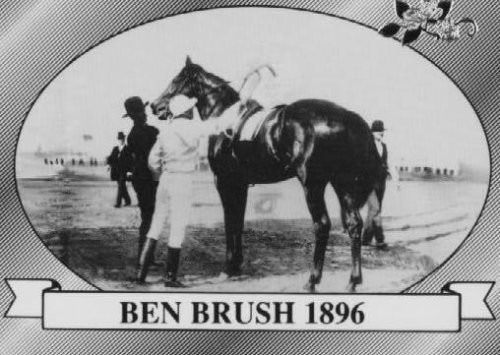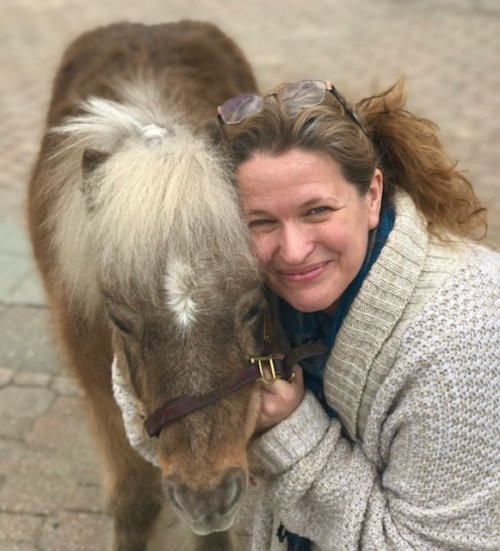Countdown to the Kentucky Derby - 123 days to go!

123 Days!!! 1896 Ben Brush was foaled by the mare Roseville, a full sister to Kentucky Derby winner, Azra. His sire was Bramble, the 1879 Handicap Champion. The foal was the result of a breeding put together by Eugene Leigh and the team of Colonel Ezekiel Clay and Colonel Catesby Woodford bought Roseville while she was in foal and sent her to their Runnymede Farm.
Ben Brush was purchased as a yearling by Eugene Leigh and trainer Ed Brown for $1200, who trained him for his first 10 starts. He won his first 5 starts in Kentucky, and then was sent East. He lost his first several races in New York, but then won his next seven. After his tenth start, he was purchased for around $15,000 by Mike Dwyer of the famous Dwyer Brothers and sent to trainer Hardy Campbell, who trained him for 6 of the 7 races in the streak. His last race prior to the Kentucky Derby was the Champagne Stakes, which he won on Halloween. At 2, he won 13 of his 16 starts, none over 7 furlongs, and was named the 2YO Champion. Going into the Kentucky Derby, Ben Brush’s main competition was a horse named Ben Eder. This Ben was being pointed specifically to this race, and was in race ready condition, while Ben Brush was coming into the race off of a lengthy layoff.
A field of eight went to the post that day, with at least 15,000 paid attendees in the crowd, not counting those in the free infield. They were treated to an amazing horse race with Ben Brush winning by a mere nose over Ben Eder. This was the first year that the Kentucky Derby was run at a mile and a quarter, and the time was 2:07 ¾.
Despite stumbling at the start and nearly dropping his jockey, he overcame what many considered the best Derby field since Spokane’s. The Courier-Journal gives the following statements from the judges: "It was a great race — one of the greatest I ever saw. We can not but regret, however, that Mr. McGuigan did not have a jockey who could do his colt justice. With an exchange of riders Ben Brush would certainly have been beaten today. He is a race horse of the highest class, however, and I think this race will do him much good. There was no doubt in the world about the finish. Simms simply lifted Brush a foot or so in front at the last jump.
“ The “History of the Kentucky Derby, 1875-1921” had a great description of the finish: “But the white face of Ben Eder had followed him through like a ghost and was coming on the outside like a flash of light. Running free and strong this true son of Fonso showed the heritage of a Derby winning sire. The family prestige must be maintained and he bid fair to do it. For one fleeting instant the white face showed before the red. But Ben Brush, too, came from an unconquered race and the blood of Bramble and old Bonnie Scotland surged through his veins as responding to the touch of steel his extended nose was thrust again an inch in front. Then Tabor made the mistake of his life. His horse was running true and comparatively fresh. The spurt of Ben Brush was only a spasmodic effort. He would have come back before the wire was reached. But Tabor reached for his whip and Ben Eder losing his jockey's aid faltered a trifle.
It was now a battle of jockeys. Both urged their mounts with whip and spur, but Tabor was riding all over his horse while Simms lifted his mount at every stride. On they came nose and nose until with an expiring effort Simms struck the wire first. It was probably the only point in the last fifty yards at which a difference could be detected between the two horses.”
Ben Brush would be the first winner to ever wear roses around his neck. A collar of white and pink roses, tied with white and magenta ribbons, were placed on the winner, and the tradition was born. The patrons were able to marvel at the eventual winner’s adornment as it was on display in front of the grandstand prior to the race. It wasn’t until 1904 that the roses were mentioned as being American Beauties, the traditional rose of today’s garlands. Ben Brush would go on to win 3 more stakes races at 3, including the Latonia Derby.
His 4YO season was impressive as he would win the Suburban Handicap and earn Championship honors at the end of the year. He retired with a record of 40 starts, 25 wins, 5 seconds, and 5 thirds. He became a Hall of Fame sire at stud. His two most notable offspring were Broomstick and Sweep, both of whom became great producers. Broomstick sired two Derby winners, one of those being Regret, the first filly to win the Kentucky Derby. Sweep would become known for his daughters. They would go on to produce three Kentucky Derby winners, two of which were Triple Crown winners, in Bubbling Over, War Admiral, and Whirlaway.



